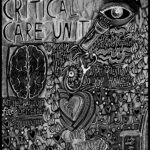Takeaway
In the face of devastating diagnoses and uncertain prognoses, pediatric patients and their loved ones need to feel heard and understood.

Creative Arts in Medicine | October 29, 2024 | 1 min read
By Sujal Manohar, medical student, Baylor College of Medicine
I created this drawing to reflect on my pediatric neurology critical care rotation. Many of the children had devastating neurological impairments, from gunshot wounds to hypoxic brain injuries. Despite often poor prognoses, it was rewarding to connect with young patients and their families by offering empathy and a listening ear. I learned not only how to adapt my physical exam skills to fit different patient presentations, but also to modify my communication, both nonverbal and verbal, to align with each patient and their loved ones.
This drawing illustrates conversations with families in the ICU, represented by teardrops and broken hearts, while also highlighting moments of hope and recovery through symbols such as hearts and reactive pupils. Elements of our discussions are woven into the piece, such as questions about code status. I was touched when one patient’s mother gave each member of our team a hug, thanking us for our help even though her daughter did not survive her injury. Emotions often blended together in the ICU, and similarly, my art piece has no clear edges between written phrases and designs. Including both words and images also reflects how both forms of communication can be valuable for patients and their caregivers.

This piece expresses the views solely of the author. It does not necessarily represent the views of any organization, including Johns Hopkins Medicine.

